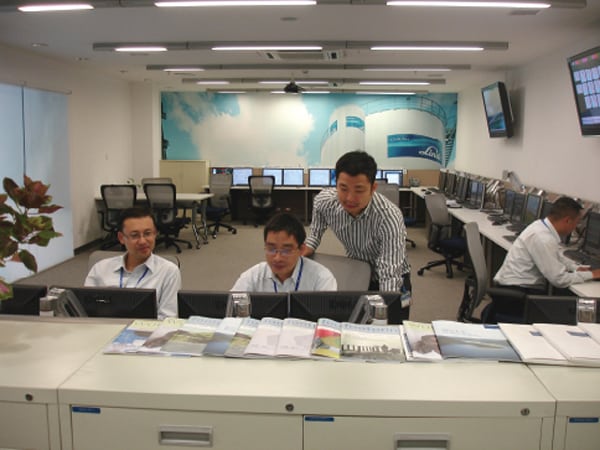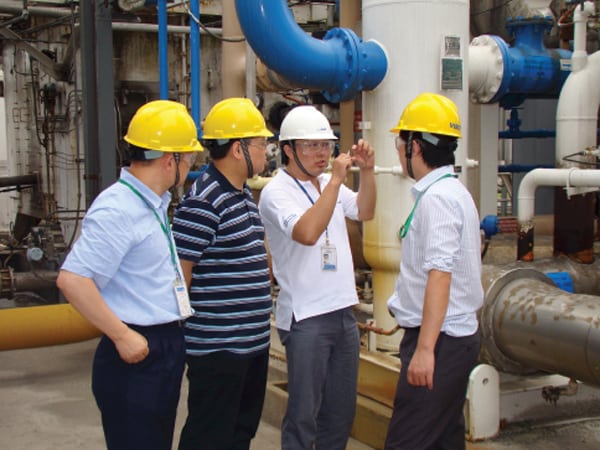Expanding the Use of Predictive Maintenance as a Business Strategy
The Linde Group is a world-leading gases and engineering company operating in more than 100 countries. It’s no surprise that the company uses a variety of advanced monitoring techniques and equipment to keep its plants operating reliably. In the U.S. and UK particularly, Linde plants have used online machine condition monitoring for a number of years. At its Shanghai headquarters, Linde has formed a large and impressive remote operations center where it monitors and tracks the process operations of all its major gas plants in China 24 hours a day (Figure 8).
 |
| 8. Remote monitoring. Henry Aung-Kyi, Linde’s reliability engineering manager for Greater China, inspects PdM and operating data at Linde’s Remote Operations Centre in Shanghai. Courtesy: SKF |
Many process and manufacturing plants use preventive maintenance (PM) programs, but PM has limited effectiveness. PM activities are usually time-based: Machine adjustments are made and replacements parts are ordered on a routine basis without regard for the operational performance or condition of the major piece of equipment or its component parts.
In contrast, predictive maintenance (PdM) is a condition-based approach that builds a picture of the anticipated condition of a component or piece of equipment based on trends of important operating data taken while the equipment is in service.
The data collected by Linde mostly consists of vibration analysis data, but it also includes lubricant analysis, temperature measurements, and the like. Based on this trend data, and applying principles of statistical process control, an engineer can predict the best time to conduct equipment maintenance. This approach allows the technician to cost-effectively plan maintenance work. Because most PdM data collection occurs when the equipment is in service, there is minimal disruption to production.
Integrating PdM
When Linde acquired the BOC gases company in 2006, it embarked on a program of integrating its new China-based assets into Linde’s PdM-based operation and maintenance (O&M) organization. Linde O&M activities are process-driven, meaning that they are focused on process optimization and continuous improvement. After the acquisition, the company’s first step was to assess the maintenance processes at each of the newly acquired plants and develop an improvement plan. Linde’s long-term goal is to bring all maintenance activities at all its plants to the same level of PdM expertise and share information and knowledge for optimal benefit of all plants. The biggest challenge for Linde was the different level of engineering experience and determining the workforce training needs at the newly acquired plants.
The Nanjing plant (a joint venture with Sinopec SPC) was the first plant selected for a pilot application of a new PdM program. The first step in developing the pilot application was to find a technology supplier. Linde invited specialist companies, including local Chinese suppliers, to demonstrate PdM service work at the Nanjing plant and propose a long-term program along with details of the services provided and the costs and anticipated benefits to Linde. After a full year of trials and negotiations, Linde selected SKF to initiate Linde’s PdM program for the China operations (Figure 9).
 |
| 9. Data discussion. SKF and Linde engineers discussing PdM data collected at Linde’s Suzhou plant. Courtesy: SKF |
Consolidating PdM Functions
There are now nine Linde plants in China running robust PdM programs. An important feature of these programs are the SKF engineers who visit each plant every three months to take machinery condition measurements and follow up with in-depth discussions and recommendations as necessary.
All data is uploaded to a central database where PdM technicians at each of Linde’s plants can access the historical trending data for the particular equipment being monitored (Figure 10). This data is useful because the same equipment is used in many of the plants.
 |
| 10. Hands-on data collection. An SKF engineer uses portable devices to collect data from an electric motor that will later be compared to operating data collected by the plant distributed control system to identify equipment performance trends. Courtesy: SKF |
The main equipment monitored is the high-speed compressors and ancillary equipment such as pumps and expansion machines. Readings are taken at positions on the compressor that indicate the condition of each of the compressor stages, which is important to the overall efficiency of the compressor. Using SKF’s portable data collector Microlog CMVA60 or CMXA70, measurements are routinely and easily collected without any disturbance to operations. Relevant data is also compared with that collected by the integrated distributed control system (DCS) that controls and monitors the compressor. Any strong deviations between the SKF data and the DCS data are then evaluated with plant technicians and a corrective action plan is prepared.
Success and Growing Cooperation
One of the important challenges for SKF was educating and training local Linde engineers in how to assess their machine data and interpret the data they collected as part of the overall PdM program. Today, Linde engineers have great confidence in their PdM program and technology and it’s a vital part of each plant’s maintenance strategy. Many problems have been identified at the first sign of deteriorating performance, such as that caused by wear, unbalance, misalignment, and overheating. By detecting these conditions early, Linde engineers now run their rotating equipment without risking catastrophic breakdown that would disrupt production and have huge downtime and cost consequences.
—Contributed by Colin Roberts ([email protected]), SKF Group